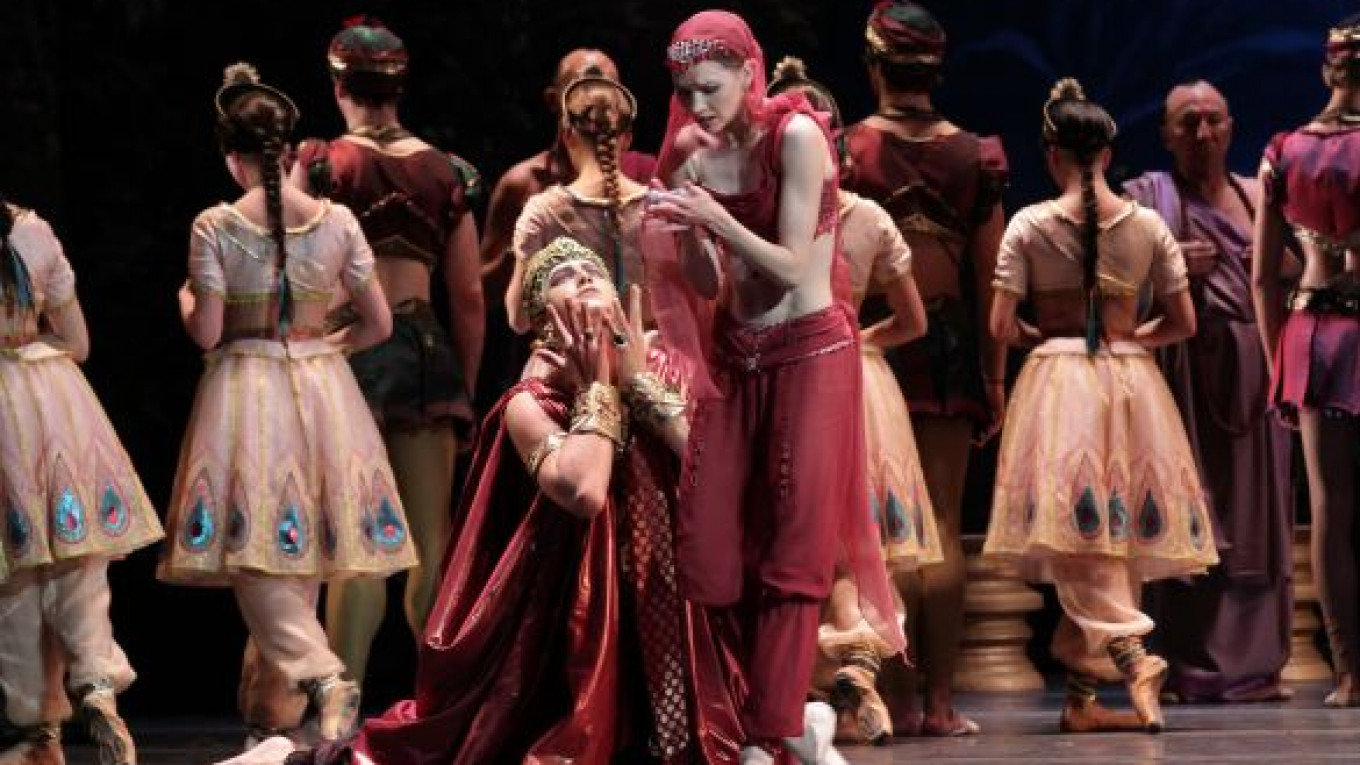There are few greater challenges in the classical ballet repertoire than "La Bayadere," one of the supreme creations of Frenchman Marius Petipa during his half-century as ballet master of what is now known as the ballet company of St. Petersburg's Mariinsky Theater.
Last month, the Stanislavsky and Nemirovich-Danchenko Musical Theater took up the challenge. The result was rather mixed, but on balance produced quite a winning show.
"La Bayadere" is set in a sort of make-believe India and concerns the love between a warrior named Solor and a temple dancer, or bayadere, named Nikia. The local rajah, however, has plans to marry his daughter, Gamzatti, to Solor. Gamzatti and her father plot to have Nikia killed by a venomous snake. In an opium-induced dream, the mourning Solor finds Nikia among the spirits of dead bayaderes in the so-called Kingdom of the Shades. But once awake, he proceeds to the temple to be married to Gamzatti. At the conclusion of the ceremony, the gods take their revenge for Nikia's death by destroying the temple and all within it. United again, Nikia and Solor ascend into the great beyond.
The ballet has undergone many changes since its premiere in 1877, including a revision by Petipa himself 23 years later. Moscow audiences know it well from a production at the Bolshoi Theater that has regularly played there since 1991. Although credited to the theater's then ballet artistic director Yury Grigorovich, the Bolshoi's "La Bayadere" essentially amounts to a copy of a version first produced at the Kirov, now Mariinsky, Theater in 1941, with a number of additions made by other choreographers, Grigorovich among them.
For its production, the Stanislavsky turned to Natalya Makarova, a rising star of the Kirov in the 1960s who left the company and, with it, the Soviet Union during a visit by the Kirov company to London in 1970. Makarova went on to achieve great acclaim with dance companies throughout the world, perhaps most notably as principal ballerina of American Ballet Theater.
Makarova first staged "La Bayadere" in 1980 and since then has restaged it at least 15 times in various parts of the world, though never before in Russia. On the basis of extensive research, she has attempted to return, with a few exceptions, to Petipa's ultimate revision of the ballet. Gone are the mostly delightful divertissements in the betrothal scene at the Bolshoi though thankfully, also the row of young black-faced boys, who I'm sure have proved as much an embarrassment to others as they have to me. The Bolshoi's production ends immediately in the wake of Solor's dream about the Kingdom of the Shades. Makarova has truncated some of the ballet's earlier scenes and restored the original final act in the temple. Besides that, her staging contains much more pantomime, as was customary in Petipa's time, than is seen at the Bolshoi.
To my mind, Makarova's version, with its wonderfully old-fashioned sets by Pier Luigi Samaritani and costumes by Yolanda Sonnabend, works quite well. The added final act has little to recommend it in the way of dancing, but does make for a more convincing finale than the Bolshoi's.
The high spots of the evening I saw it, with the first of three casts, were the famous Entrance of the Bayaderes in Kingdom of the Shades scene and the dancing of Solor by the company's brilliant premier danseur Sergei Polunin.
The Entrance of the Bayaderes, certainly one of Petipa's most spectacular creations, calls for 32 female members of the corps de ballet to slowly descend a mountain path in synchronized arabesques. Once all have reached the stage floor, they go on to dance a series of movements that require the very utmost in coordination.
While the dancers of Stanislavsky failed to display in their descent the near-perfect arabesques and the confidence usually seen at the Bolshoi, once they reached the stage floor they seemed almost magically transformed and quite rightly drew the evening's warmest ovation.
Polunin brought to Solor the same grace, elegance and ease of movement that he has shown in his other roles since joining the Stanislavsky troupe summer before last and that set him apart from every other male dancer on the Moscow stage.
Natalya Somova, as Nikia, and Erika Mikirticheva, as Gamzatti, both of them seen to excellent effect on other occasions, came nowhere near to matching Polunin. Unlike him, neither acted the pantomime with much conviction and neither danced with the panache their roles required. But excellent ballerinas that they are, I would expect to see better things from both of them in future performances.
"La Bayadere" (Bayaderka) next plays on Nov. 28 and Jan. 10 and 11 at 7 p.m. at the Stanislavsky and Nemirovich-Danchenko Musical Theater, located 19 Bolshaya Dmitrovka. Metro Chekhovskaya, Pushkinskaya. Tel. (495) 723-7325. www.stanmus.ru.
Contact the author at [email protected]
A Message from The Moscow Times:
Dear readers,
We are facing unprecedented challenges. Russia's Prosecutor General's Office has designated The Moscow Times as an "undesirable" organization, criminalizing our work and putting our staff at risk of prosecution. This follows our earlier unjust labeling as a "foreign agent."
These actions are direct attempts to silence independent journalism in Russia. The authorities claim our work "discredits the decisions of the Russian leadership." We see things differently: we strive to provide accurate, unbiased reporting on Russia.
We, the journalists of The Moscow Times, refuse to be silenced. But to continue our work, we need your help.
Your support, no matter how small, makes a world of difference. If you can, please support us monthly starting from just $2. It's quick to set up, and every contribution makes a significant impact.
By supporting The Moscow Times, you're defending open, independent journalism in the face of repression. Thank you for standing with us.
Remind me later.






